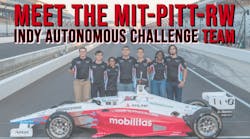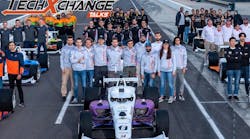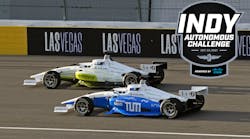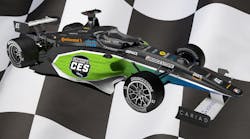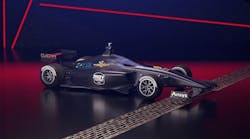Indy Autonomous Challenge 2024: AI at High Speed
The Indy Autonomous Challenge (IAC) held the seventh edition of its autonomous racing competition, returning to the Indianapolis Motor Speedway. New world autonomous speed records were set for top speed on a racetrack (184 mph) and fastest passing overtake (180 mph).
Competing Teams in This Year’s IAC
Nine teams, representing 13 universities, competed with identical IAC AV-24 racecars at the 2024 Indy Autonomous Challenge. Competing teams included:
- AI Racing Tech (ART) – University of California, Berkeley, with University of Hawai’i, University of California, San Diego, and Carnegie Mellon University (U.S.)
- Autonomous Tiger Racing (ATR) – Auburn University (U.S.)
- Cavalier Autonomous Racing (CAR) – University of Virginia (U.S.)
- IU Luddy – Indiana University Luddy School of Informatics (U.S.)
- KAIST – Korea Advanced Institute of Science and Technology (South Korea)
- PoliMOVE-MSU – Politecnico di Milano, Michigan State University, and University of Alabama (U.S., Italy)
- Purdue AI Racing (PAIR) – Purdue University (U.S.)
- UNIMORE Racing – University of Modena and Reggio Emilia (Italy)
- TUM Autonomous Motorsport – Technische Universität München (Germany)
The Caltech team, a new addition to the competition, was present at the track and will participate in the 2025 CES (Consumer Electronics Show) event.
>>Check out these articles and videos from previous IAC racing events
Racecar Hardware Specifications
- LiDAR (four sensors): Luminar Iris 275-meter max range, 30-fps scan rate
- Radar (two sensors): Continental ARS 548 RDI; 300- to 1500-m range; 120-degree FoV
- Cameras (six): Allied Vision Mako G-319C Edmund Optics Lens 37.6 fps max frame rate
- High-performance GPS: VectorNav VN-310
- Cisco IE-3300 switches
- Intel Xeon server with 14 TB of on-board storage
- A drive-by-wire system
- Bridgestone tires
- Onboard computing: dSPACE Autera Autobox; CPU: Intel Xeon D-2166NT 3 GHz; GPU: NVIDIA A 5000
- Engine: Inline 4-piston Honda K20C turbocharged, 2 liters, 488 hp at 6,500 rpm; 382 ft-lb torque
- Dallara chassis: 1690 lbs., 192 × 76 × 45.5 in. (LWH); since 2001, Dallara has been the sole chassis supplier of the Indy Lights series, a championship whose main goal is to prepare drivers for the NTT IndyCar Series
- Communications/networking: Cisco IE-3300; Marelli SA 130 telemetry; AVI LTE 9111 modem; Verizon 4G cellular network
Results from the 2024 Indy Autonomous Challenge
For the speed competition, each team has seven minutes of timed laps with the average speed of their fastest lap determining their place. The Cavalier team (University of Virginia) won first place, making it the first time that a U.S. team has won this competition. They reached a maximum speed of 184 mph, which is a record for the IAC competition, and an average speed of over 171 mph around the iconic racing oval.
The Passing competition is a head-to-head race that involves two racecars on the track at the same time. The two racecars must complete a pass within one full lap at increasing speed levels.
For this competition, assessing the other vehicle and its tactics to pass or maintain the lead is critical. PoliMOVE-MSU (Politecnico di Milano, Michigan State University) won the passing competition with a record-setting overtake speed of 180 mph.
Other Events at the Indy Autonomous Challenge
In addition to the head-to-head race, the day included several events that offered attendees a chance to learn about and engage with such technologies as autonomous vehicles, drones, robots, augmented and virtual reality, generative AI, sensor fusion, internet of things, etc.
One of these events was the Innovation Paddock, located in the Trackside Garages adjacent to the track. It featured interactive hard-tech exhibits by industry-leading companies, startups, universities, and innovation-based non-profits. IAC partnered with the Indiana Department of Education (IDOE) to invite high-school students to their race. Attendees as well as the 1,500 students from all around Indiana had access to the Innovation Paddock exhibits.
The Future Mobility Summit was an invitation-only summit held in the Gallagher Pavilion at the Speedway. It centered around advances such as AI-driven autonomy, next-generation drones, smart infrastructure, and sustainable-energy solutions.
Keynotes and panel sessions were steered by senior leaders from industry, government, and academia, including Bridgestone, Stellantis, Salesforce, DoorDash, Beyond Limits AI, dSPACE, Luminar, Korn Ferry, US Department of Defense (DARPA), MIT Lincoln, UC Berkeley, and Politecnico Di Milano.
Key takeaways from the summit:
- We don't know how to model things perfectly. We shouldn't be misled by the success of ChatGPT because their problem space is so much different. How do we instead come up with entirely new methods to transfer autonomy to the real world?
- Teams are using simulators, with the understanding that there’s still a 5% to 10% gap from what you cast as the simulation and what you see when you go on track (due to friction on the road and so on).
- The next goal is to bring the simulator on board—this will represent a huge quantum leap. The idea is to have a digital friend on board that can be tuned during runtime. However, there are at least two big problems: Automotive now isn’t equipped to run a full-fledged simulator onboard, and each team has different simulators they use for different purposes. It has been very difficult to get those teams to do head-to-head simulation races because they don't all use the same simulator.
- If you can accomplish what’s known as the twin in the loop, this will allow teams to have more head-to-head racing in the cloud. The issue is how do you scale up and be able to run parallel simulations in the cloud, and how do you judge the effectiveness of knowledge transfer between sim-to-real environments?
- For the long run the brute-force approach: More and more data, bigger and bigger models, building gigawatt-level compute sites that are then trained on terabytes if not petabytes worth of data. We can’t rely on big, institutional data-center assets that are going to be fed with real-world data coming in. Right now, after a 15-minute racecar run, the car comes back, is then attached to an umbilical cord, and roughly three terabytes of data is pulled off that car. You’re now talking about the need for petabytes of disk space to manage all of this data.
- Then there’s the cost. Google trains Gemini Ultra at a cost of some $200 million. Who can afford to train these models?
- The way teams see it, the important thing is relevant data. You may have 1,000 miles of highway driving, but it's the few seconds of coming to an exit or an entry point where there may be other actors getting in your way that are essential. That’s the part where you want to make sure your AI driver is able to work with and take corrective action.
- In 10 years, autonomous racing may have human and AI drivers competing together. To do so, you need augmented reality for the drivers because the driver should see the digital opponent. This in-between situation is going to be very interesting in the next few years, as it will involve a real mix between digital and physical worlds.
- The most important data occurs when the vehicle doesn't operate correctly. Then we want to analyze that data; you drive in the real world, collect data, compare it to simulation, and make corrections, recognizing that if you go to a burger restaurant and you're collecting data from all your customers, you're going to naturally conclude that everybody loves burgers, but you're not capturing the customers that aren't going to the burger restaurant. So you have to make sure all the data you are collecting is complete.
Autonomous Cars in Future Races?
So when will we see traditional car racing with multiple autonomous cars on track? Very soon, according to the IAC president and CEO Paul Mitchell: “Possibly as soon as Las Vegas (CES). Definitely in 2025.”

